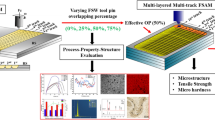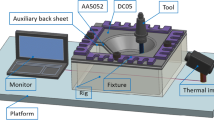Abstract
Material flow is evaluated to investigate the mechanism of pin-less friction stir-assisted incremental forming with synchronous bonding (FS-ISF&SB) process in a macro and micro scope. Dissimilar metal sheets AA5052-H32 and DC05 are incrementally formed with synchronously bonding by this novel process. Analytical mechanical models combined with microscopic image reveal that materials experience severe but different flow modes during the process. To make clear the underlying forming mechanism, the fabricated part is divided into three zones: wall flow zone (WFZ), rotation flow zone (RFZ), and bump structure flow zone (BSFZ). Bonding may even appear at Fe-Al interface to produce Fe-Al intermetallic compound in WFZ and RFZ, which depends on uncoordinated deformation controlled by mechanical force coupled with heat. Contributed to the torque transfer applied by forming tool, obvious wall side deflection in WFZ and grain refinement at the near surface area in RFZ are observed. Based on the simulation characterization, thermal effect is considered to build force frame on the deformation element for making semi-quantitative investigation of softening effect on BSFZ. This work prompts a better understanding of the underlying mechanism of this process and establishing the process window for potential industrial applications.















Similar content being viewed by others
Abbreviations
- ∆h:
-
Step down (mm)
- μ :
-
Coefficient of friction
- v :
-
Feed rate (mm/s)
- ω :
-
Forming tool rotation speed (rpm)
- \( \overline{\varepsilon} \) :
-
Equivalent plastic strain
- T r :
-
Room temperature (°C)
- R t :
-
Tool radius (mm)
- T melt :
-
Material melting temperature (°C)
- εt, εφ, εθ :
-
Strain in thickness, tangential, and circumferential directions
- σt, σφ, σθ, τtθ :
-
Normal stress in thickness, tangential, circumferential directions, and shear stress (MPa)
- tU, tL :
-
Current thickness of upper and lower layer (mm)
- k,n :
-
Coefficient in material hardening rule
- K,n :
-
Coefficients in Hollomon material hardening rule
- r h :
-
Part radius at current height (mm)
- \( \overline{\upsigma} \) :
-
Equivalent stress (MPa)
- θ :
-
Circumferential contact angle (°)
- t 0 :
-
Initial sheet thickness (mm)
- σs :
-
Yield stress (MPa)
- β :
-
Forming angle (°)
- R d :
-
Designed maximum opening radius of part (mm)
- σtb :
-
Boundary stress in thickness direction (MPa)
References
Chaudhari GP, Acoff V (2009) Cold roll bonding of multi-layered bi-metal laminate composites. Comp Sci Technol 69(10):1667–1675
Parvizi A, Afrouz F (2016) Slab analysis of asymmetrical clad sheet bonded before rolling process. Int J Adv Manuf Technol 87(1–4):137–150
Guo X, Wang H, Liu Z, Wang L, Ma F, Tao J (2016) Interface and performance of CLAM steel/aluminum clad tube prepared by explosive bonding method. Int J Adv Manuf Technol 82(1–4):543–548
Jia J, Zhu WW, Xiong W, Zhou JL (2014) Influence of diffusion ways on morphology of plating layers of hot dip aluminizing stainless steel sample. Trans Mater Heat Treat 35:205–209
Al-Ghamdi KA, Hussain G (2016) On the comparison of formability of roll-bonded steel-Cu composite sheet metal in incremental forming and stamping processes. Int J Adv Manuf Technol 87(1–4):1–12
Bouayad A, Gerometta C, Belkebir A, Ambari A (2003) Kinetic interactions between solid iron and molten aluminium. Mater Sci Eng A 363(1–2):53–61
Yazar Ö, Ediz T, Öztürk T (2005) Control of macrostructure in deformation processing of metal/metal laminates. Acta Mater 53(2):375–381
Choi SH, Kim KH, Oh KH, Dong NL (1997) Tensile deformation behavior of stainless steel clad aluminum bilayer sheet. Mater Sci Eng A 222(2):158–165
Hino R, Goto Y, Yoshida F (2003) Springback of sheet metal laminates in draw-bending. J Mater Process Technol 139(1):341–347
Bagherzadeh S, Mollaei-Dariani B, Malekzadeh K (2012) Theoretical study on hydro-mechanical deep drawing process of bimetallic sheets and experimental observations. J Mater Process Technol 212(9):1840–1849
Cheon J, Yoon JY, Kim C, Na SJ (2018) A study on transient flow characteristic in friction stir welding with real-time interface tracking by direct surface calculation. J Mater Process Technol 255:621–634
Liu XC, Sun YF, Morisada Y, Fujii H (2018) Dynamics of rotational flow in friction stir welding of aluminium alloys. J Mater Process Technol 252:643–651
Mironov S, Masaki K, Sato YS, Kokawa H (2012) Relationship between material flow and abnormal grain growth in friction-stir welds. Scrip Mater 67(12):983–986
Lorrain O, Favier V, Zahrouni H, Lawrjaniec D (2010) Understanding the material flow path of friction stir welding process using unthreaded tools. J Mater Process Technol 210(4):603–609
Behera AK, de Sousa RA, Ingarao G, Oleksik V (2017) Single point incremental forming: an assessment of the progress and technology trends from 2005 to 2015. J Manuf Process 27:37–62
Barnwal VK, Chakrabarty S, Tewari A, Narasimhan K, Mishra SK (2018) Forming behavior and microstructural evolution during single point incremental forming process of aa-6061 aluminum alloy sheet. Int J Adva Manuf Technol 95:921–935
Fang Y, Lu B, Chen J, Xu DK, Ou H (2014) Analytical and experimental investigations on deformation mechanism and fracture behavior in single point incremental forming. J Mater Process Technol 214(8):1503–1515
Bakavos D, Chen Y, Babout L, Prangnell P (2011) Material interactions in a novel pinless tool approach to friction stir spot welding thin aluminum sheet. Metal Mater Trans A 42(5):1266–1282
Ambrogio G, Filice L, Gagliardi F (2012) Improving industrial suitability of incremental sheet forming process. Int J Adv Manuf Technol 58(9–12):941–947
Lu B, Fang Y, Xu DK, Chen J, Ou H, Moser NH, Cao J (2014) Mechanism investigation of friction-related effects in single point incremental forming using a developed oblique roller-ball tool. Int J Mach Tools Manuf 85:14–29
Lu B, Fang Y, Xu DK, Chen J, Ai S, Long H, Ou H, Cao J (2015) Investigation of material deformation mechanism in double side incremental sheet forming. Int J Mach Tools Manuf 93:37–48
Cai S, Wu RH, Wang ZH, Li M, Chen J (2020) Coupled thermo-mechanical modeling of friction stir assisted incremental forming with synchronous bonding of heterogeneous sheet metals. Int J Adv Manuf Technol 106:2747–2763
Ai S, Lu B, Chen J, Long H, Ou H (2017) Evaluation of deformation stability and fracture mechanism in incremental sheet forming. Int J Mech Sci 124-125:174–184
Hollomon JH (1945) Tensile deformation. Trans AIME 162:268–290
Giuseppina A, Claudio C, Luigino F, Francesco G (2016) Theoretical model for temperature prediction in incremental sheet forming – experimental validation. Int J Mech Sci 108-109:39–48
Zienkiewicz OC, Cormeau IC (2010) Visco-plasticity—plasticity and creep in elastic solids—a unified numerical solution approach. Int J Num Meth Eng 8(4):821–845
Leon MD, Shin HS (2015) Material flow behaviours during friction stir spot welding of lightweight alloys using pin and pinless tools. Sci Technol Weld Join 21(2):140–146
Funding
The authors received financial funding from National Natural Science Foundation of China under grant # 51675332 and Program of Shanghai Excellent Academic Research Leadership (19XD1401900).
Author information
Authors and Affiliations
Corresponding author
Additional information
Publisher’s note
Springer Nature remains neutral with regard to jurisdictional claims in published maps and institutional affiliations.
Rights and permissions
About this article
Cite this article
Wu, R., Li, M., Liu, X. et al. Characterization of material flow in friction stir-assisted incremental forming with synchronous bonding of dissimilar sheet metals. Int J Adv Manuf Technol 109, 2523–2534 (2020). https://doi.org/10.1007/s00170-020-05782-0
Received:
Accepted:
Published:
Issue Date:
DOI: https://doi.org/10.1007/s00170-020-05782-0




